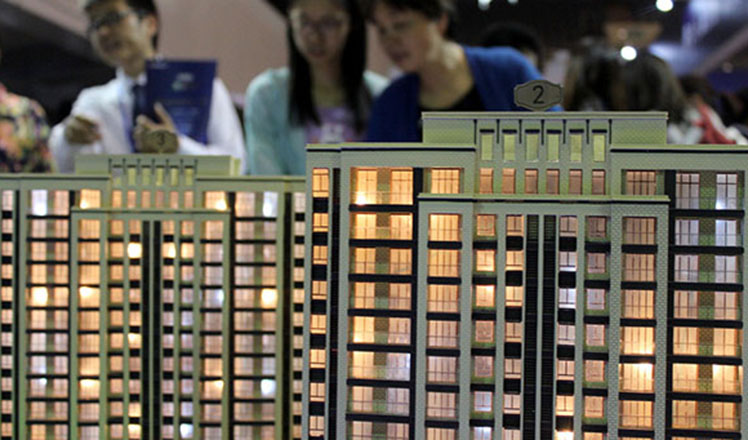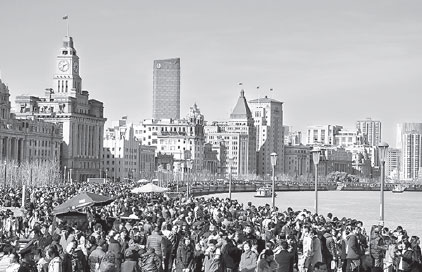Shanghai's population growth subsides
Updated: 2015-12-25 08:01
By Zhou Wenting in Shanghai(China Daily)
|
|||||||||
Urbanization brought pressures, but regulation to manage numbers succeeded, experts said
Multiple measures implemented since last year intended to curb a rapid rise in Shanghai's population have been effective, and the city's population growth will plateau in the coming few years, experts said.
Experts made the remarks on Thursday after the city's Party committee said that a ceiling on the city's permanent resident population is targeted for below 25 million by 2020, an increase of 740,000 from the current figure.
Shanghai has been facing persistent population pressure due to rapid urbanization and the comparatively high income standard in the city. The latest numbers from the Shanghai Municipal Statistics Bureau showed that the number of permanent residents surged from 16.08 million in 2000 to 24.26 million in 2014. Among the permanent residents last year, 14.29 million had household registration in Shanghai.
"The various regulatory measures taken since last year have actually made the city's total population, including the mobile population, lower than what it was two years ago. The city's permanent population is predicted to become steady, or may even show a negative growth," said Zhou Haiwang, deputy director of the Institute of Urban and Population Development Studies at the Shanghai Academy of Social Sciences.
He said the regulations have targeted mainly immigrants, as they contributed significantly to Shanghai's jump in population.
One measure was the adjustment of industrial structure and the reduction in the number of jobs, Zhou said, especially in low-end manufacturing.
Another measure was to dismantle unapproved construction projects in residential communities, especially those properties that were expanded or renovated by the owners.
"For example, more than 2 square km of such construction was torn down in Xupu village, Huacao town of Minhang district, earlier this year and more than 6,000 people were found to have settled in the illegally expanded establishments without holding a residence permit," Zhou said.
The point system for a migrant resident, which took effect in July 2013, was one way to control the population rise, experts said.
The system translates migrants' personal circumstances and contributions into points on their residence permits corresponding to the public services that they are eligible for. The points will be accumulated and a total of 120 can win the migrant resident major social benefits, such as social insurance or allowing their children to take the national college entrance exam in Shanghai.
High-end talents will be prioritized in applying for permanent residence as Shanghai's quest to become a global science and technology center by attracting top talent from home and abroad is quickly gathering pace.
Ren Yuan, a professor from the School of Social Development and Public Policy at Fudan University, said the economic boom in neighboring Zhejiang and Jiangsu provinces will reduce the pressure on the city.
"When the root cause of the development gap between regions is alleviated, the one-way flow of population migration will slow down," he said.
Zhou forecast that it's very possible Shanghai will have 30 million people by 2030, and he believed the rise will be essential to improve the age structure of the population in the long term.
"Moreover, decisions in every aspect of social and economic development should be based on consideration of population growth. Otherwise the difficulty of admission to kindergartens and primary schools will go on and the fact that a doctor in a hospital in Shanghai will see hundreds of patients on a daily basis won't change," Zhou said.
zhouwenting@chinadaily.com.cn

|
People visit the Bund on the banks of the Huangpu River in Shanghai in February. Zhou Dongchao / for China Daily |
(China Daily 12/25/2015 page4)
- More aid from China set for Syria
- Japanese journalist reportedly being held in Syria
- New York City has warmest Christmas Eve on record
- One dead as fight leads to fatal shooting at North Carolina mall
- Trump's lead bodes well for Hillary Clinton's presidential bid
- Spanish Socialist leader insists no support for Rajoy

 China's top scientific achievements in 2015
China's top scientific achievements in 2015
 Yearend 2015: A picture and its story
Yearend 2015: A picture and its story
 Christmas celebrated across the world
Christmas celebrated across the world
 HK car show kicks off during Christmas season
HK car show kicks off during Christmas season
 10 major economic policies that will make a difference on lives
10 major economic policies that will make a difference on lives
 Santa Claus is busy in China
Santa Claus is busy in China
 Yearend 2015: Heartstopping images captured by daredevils
Yearend 2015: Heartstopping images captured by daredevils
 Girl becomes youngest Master of Memory
Girl becomes youngest Master of Memory
Most Viewed
Editor's Picks

|

|

|

|

|

|
Today's Top News
Shooting rampage at US social services agency leaves 14 dead
Chinese bargain hunters are changing the retail game
Chinese president arrives in Turkey for G20 summit
Islamic State claims responsibility for Paris attacks
Obama, Netanyahu at White House seek to mend US-Israel ties
China, not Canada, is top US trade partner
Tu first Chinese to win Nobel Prize in Medicine
Huntsman says Sino-US relationship needs common goals
US Weekly

|

|









